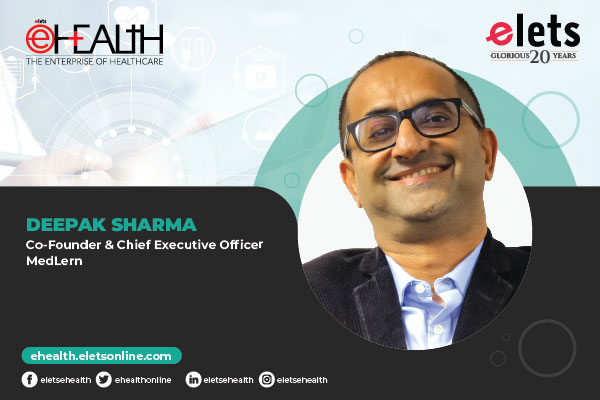
With the remarkable expansion of smartphone usage and the ever-growing reach of the internet throughout India, experts predict an astonishing surge in the AR and VR market, projected to increase by over eleven times from 2000 to 2023. Additionally, forecasts indicate that the Indian AR and VR sector could exceed $14 billion by 2027. Notably, the healthcare domain stands as a prominent beneficiary of the escalating adoption of immersive technologies such as Augmented Reality (AR), Virtual Reality (VR), and Mixed Reality (MR). This surge owes its momentum partly to the pandemic’s demands and the emergence of innovative startups that are aggressively pushing boundaries, potentially ushering in a transformative virtual revolution within the healthcare industry.
For a country like India, grappling with an inadequate healthcare infrastructure and a shortage of trained healthcare professionals (HCPs), the growing integration of these immersive technologies holds the potential to significantly enhance patient care and outcomes.

In what ways can these immersive technologies reshape patient care and the broader landscape of Indian healthcare? Let’s explore their potential impact:
Revolutionising medical education
Given the deeply immersive nature of AR, VR, and MR, they possess the capacity to elevate online and remote medical education to unprecedented heights. Students can now delve into the intricacies of human anatomy in ways previously deemed impossible. Practicing on a digital replica of the human body enables them to perform tasks ranging from simple incisions to complex surgeries, all of which demand extensive practice. These technologies facilitate comprehensive learning through interactive experiences, enhancing efficiency and speed. Consequently, student engagement levels are expected to rise, translating to improved real-world performance. For India, struggling with both a shortage of doctors and quality medical professionals, the expanding influence of these technologies could significantly elevate the standard of healthcare.

Empowering patient education and engagement
AR, VR, and MR technologies hold the potential to revolutionise patient education, particularly in cases involving surgical procedures. By providing patients with immersive experiences, these technologies allow for a deeper understanding of the necessity and process of surgical interventions. This heightened comprehension contributes to reduced stress, anxiety, and pain, thereby promoting more effective mental rehabilitation. Patients’ ability to describe their symptoms is also enhanced in a virtual environment, thanks to the additional digital cues they perceive. Furthermore, these technologies foster improved communication between doctors, patients, and their relatives – an aspect often identified as lacking in the Indian healthcare system. Notably, certain pharmaceutical companies even enable patients to visualise the effects of drugs in three dimensions within their own bodies.
Enhancing surgical precision and efficiency
The adoption of immersive technologies has the potential to refine surgical procedures, enhancing accuracy and efficiency, ultimately leading to improved surgical outcomes. Surgeons can practice intricate procedures on digital human models before performing actual surgeries, allowing them to visualise complex scenarios, identify potential risks, and devise alternative approaches beforehand. As a result, their performance in real-world settings becomes markedly more precise. Holographic overlays of patient vitals data and images in real-time aid surgeons in making swift and well-informed decisions during procedures. Given the reported 82% shortfall of surgeons in rural India, the integration of AR and VR into surgical practices becomes even more imperative.
Enabling remote consultation and diagnostics
Immersive technologies have the potential to redefine telehealth and telemedicine, making remote consultation and diagnostics more commonplace across India. These technologies facilitate near-replication of real-world discussions between doctors, diagnostic experts, and patients, thereby enhancing overall efficiency. With India grappling with a severe shortage of doctors and specialists, the advent of these immersive technologies could serve as a crucial solution, particularly for underserved regions and smaller towns.
Addressing mental health conditions
The effectiveness of immersive technologies in addressing a wide range of mental health conditions, including anxiety disorders, depression, phobias, addictions, and even early detection of schizophrenia, has been well-documented. VR exposure therapy and AR exposure therapy have proven successful in various cases, offering a promising avenue for managing India’s substantial mental health burden.
Facilitating pain management
Immersive technologies have demonstrated their utility in simplifying pain management for both healthcare providers and patients. Patients exposed to virtual reality environments often report heightened pain tolerance. Virtual mirror therapy, in particular, has shown promise in this regard.
In conclusion, the increasing adoption of AR, VR, and MR technologies promises to revolutionise patient care delivery in India. Beyond enhancing disease diagnosis and treatment accuracy, these technologies offer additional benefits such as physical, cognitive, and psychological patient rehabilitation. While the current focus of immersive technology startups is predominantly on software development rather than hardware like virtual headsets, it is foreseeable that Indian companies will advance into hardware production in due course.
Views expressed by: Deepak Sharma, Co-Founder and CEO, MedLern
Be a part of Elets Collaborative Initiatives. Join Us for Upcoming Events and explore business opportunities. Like us on Facebook , connect with us on LinkedIn and follow us on Twitter , Instagram.












